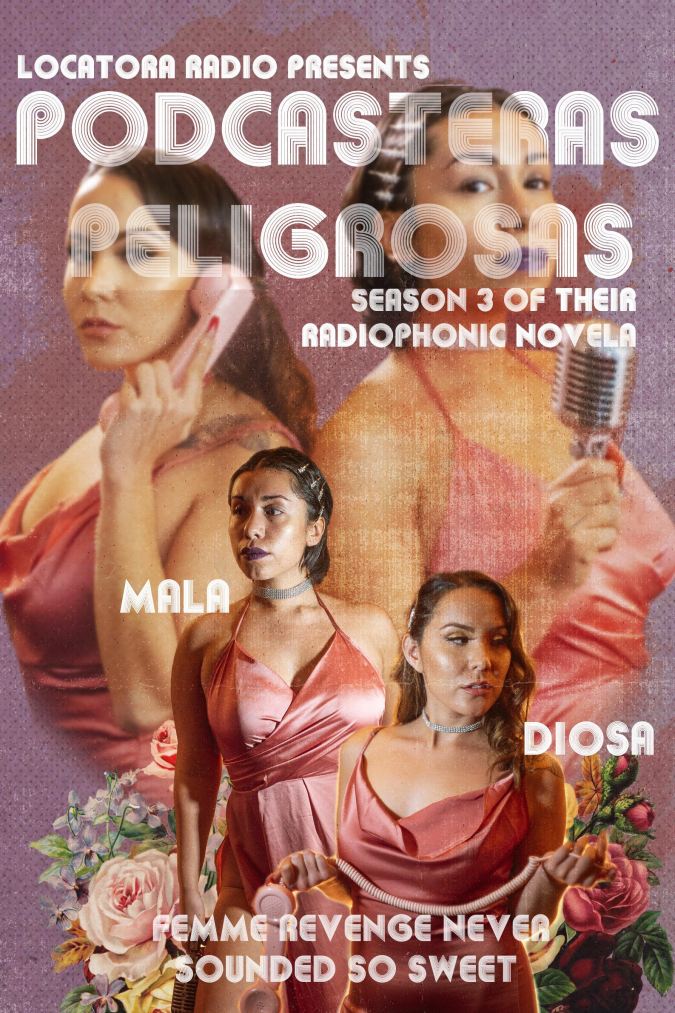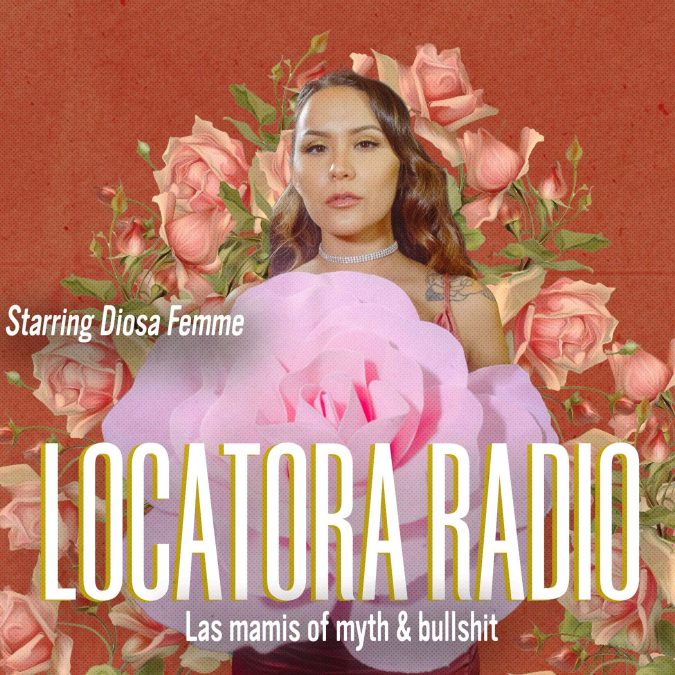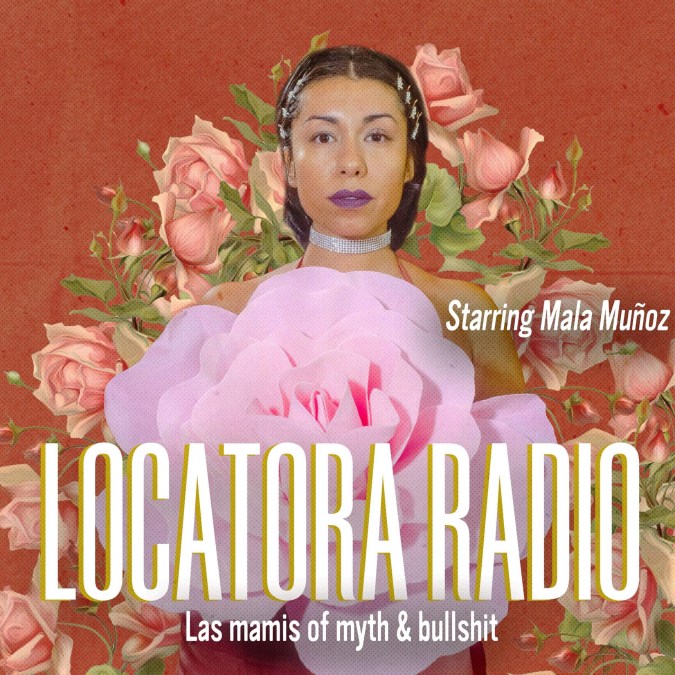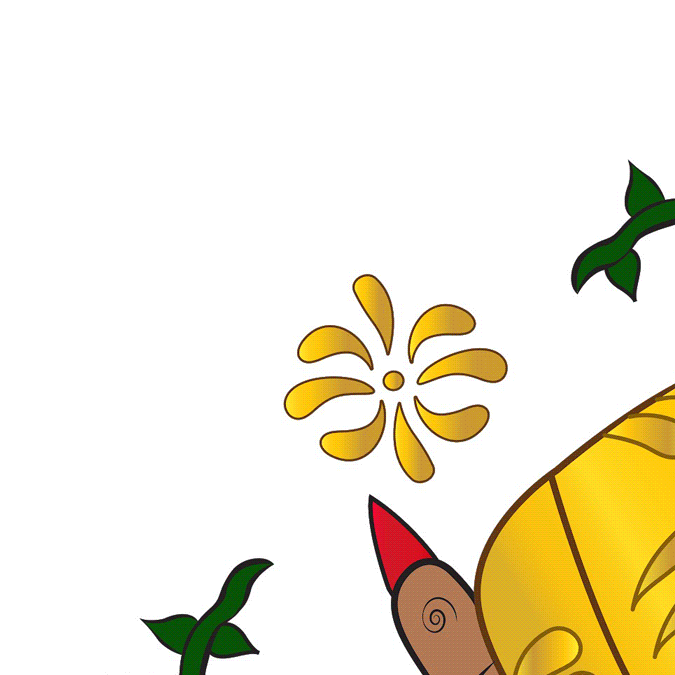When they showed up on a Friday in November to the Civic Center Studios in Los Angeles – the site of the podcast party they threw to celebrate the second anniversary of Locatora Radio – Diosa Femme and Mala Muñoz wore matching custom-made rose pink outfits. The pair bookended their guests on the stage, which was decked out in several shades of pink, as a bright magenta light shone on them. Anyone who has followed Mala and Diosa – aka Las Mamis of Myth and Bullshit – would recognize that this party felt familiar. It felt like them.
In the few years since Diosa and Mala have used Locatora Radio, which they describe as a radiophonic novela, to uplift women and femmes of color and to challenge to patriarchy, they have gained a significant following because of the important work they do. But it’s also because the two have mastered how to effectively tell their story through videos and other visuals.
To promote the Locatora Live party, for example, Diosa and Mala shot a video that had them act as a mix of lifeline operators, private investigators, and superheroes. As they invited their followers to call their fictional lifeline (833-OYE-LOCA), the phone rang. “Locatora Lifeline. What? Como? Uh-huh. Uh-huh. OK. OK, yeah. Besitos,” Diosa said, hanging up before she turns to Mala. “Acts of machismo and patriarchy threatening the mujeres of the city.” Mala dramatically typed on her keyboard so she could pull up the coordinates. And in the next scene, the two – now wearing matching pink trench coats – do a slow-mo walk as Cardi B’s “Money” played.
For anyone else, this playful video may have fallen flat. For the duo behind Locamora, this video was an endearing extension of themselves, and it did what it set out to do: build excitement for their party. Part of the reason it worked is because they take every detail into account. Mala and Diosa wrote the script for the video, which Jazmin Ontiveros shot and directed, themselves. But it’s also because Diosa and Mala are on the same wavelength, so much so that it may be surprising to learn that they aren’t lifelong friends.

“We had been following each other on Twitter and then on Instagram for a few years before we actually met in real life,” Mala told me over the phone. “We’re both from LA. She went to college in Santa Barbara, and then, I went to college in Boston, and we had never interacted in person; we had only interacted online.”
But after graduating college, they both, independently, decided to attend an event hosted by Chingona Fire that was sure to gather other feminist women. After they and other women became a tight-knit crew, Mala and Diosa decided to launch Locatora Radio in 2016.
“At the time, there weren’t very many Latinx podcasts and from what I saw, there weren’t any femme of color-centered AND survivor-centered ones,” Diosa wrote in a message. “I knew that that’s where we could enter and make our own space. Little did we know, our content was going to blow up, which goes to show there’s a need and want to hear survivor stories, counter-narratives, and where the party meets [academia].”
Wanting to move away from conchas, hot cheetos, and Selena – which are often used to make a connection to Latinidad – they Googled words associated with radio and audio in Spanish and English and tried to transform them into something meaningful. “I came upon the word locator,” Mala said. “That’s how we came upon locatora. And then in some ways, we kind of drew meaning once we created the word. Then we said, ‘Oh, OK. This makes sense to us because this is what we’re about.’ We’re about reclaiming our identities as survivors, as women in a resistance, as women who are called crazy.”
In a short time, Diosa and Mala have provided one steady message with their branding. Given that the Latinx community is among the most entrepreneurial – despite rarely having the same resources or access to information – we have decided to tap several Latinx creators and ask them how they accomplished. Below, learn how the duo behind Locatora built a brand with a strong message.
On Their Aesthetic
Diosa Femme: Over the past three years, our style has evolved, but what has remained the same is being undeniably femme and powerful. Whether it be a femme fatale aesthetic, militant femme, or high femme looks – centering, honoring, and praising the feminine has been its core.
Mala Muñoz: What we aim to do is create an aesthetic that is unapologetically feminine, that is boldly feminine, that is like soft, but also hard at the same time. Sometimes we see criticisms of like, “You’re a pretty girl, but what else do you have to offer?” “Oh, you pose selfies, but what else do you have to offer?” “You post selfies, but what’s in your brain?”
There’s always this assumption that when women take pictures of themselves or flaunt images of themselves, that that’s kind of indication that we lack in other areas, like in our work or in our intelligence. We want to put ourselves out there and center our faces because this is who we are, this is important and we can be all of it, we can be both.

On Their Inspiration
DF: We were really inspired by Mexican cinema film posters from El Siglo de Oro. We found so many posters with women portrayed as villains, such as La Devorada, La Malquerida, La Vampira, etc., which inspired our season three visuals and why we’re calling Season 3, Podcasteras Peligrosas: Femme Revenge Never Sounded So Sweet.
MM: We drew a lot of inspiration from old school, vintage film posters, like from the Golden Age of Mexican cinema. We looked at a lot of posters for movies starring Dolores del Río, María Félix. This is how we got our theme for [season three], just seeing this ongoing, continuous tendency in old school film to paint women as dangerous and sexually dangerous.
On How Their Heritage Plays a Role
DF: I think coming from two cultures allows me to play with concepts and blend ideas. I come from a lineage of vibrant women and that inspires me to create media that hasn’t been created. Latinidad is not a monolith, meaning we don’t all have to use the same images, icons, and colors. I think being Peruvian and Mexican has let me push my own creativity.
MM: The topics that are being discussed, the stories that are being shared, the imagery, it ends to be – especially in LA – very Chicanx focused, very Mexican, Mexican-American, even Central American now more and more and more. We wanted to say that we could also draw from Diosa’s Peruvian background and our jingle actually has a sample of a song by Yma Sumac, who’s a Peruvian singer. So we definitely wanted to draw from our own backgrounds because that’s who we are. Where else would we draw inspiration from? And we love our cultures. There’s so much info there that has yet to be uncovered.

On Why Their Branding Works
DF: “Everything we’ve learned through Locatora has been trial and error. We started creating our own graphics for capitulo announcements, fliers here and there, but as we became more immersed in the world of creators, we started to hire graphic designers to help us execute our vision.
Even though we’re a podcast and what we’re creating is audio, the visuals are just as important to us. That’s one reason we call the podcast a radiophonic novela. A novela is something you keep up with, you and your tías are glued to the TV and are excited to follow the stories and characters. The visuals allow us to bring our radiophonic novela to life. I think it works because it’s original and authentic. We try really hard to push ourselves, be creative, and be thematic.

MM: For the most part so far, we’ve been really fortunate that we are surrounded by so many creative people and for the most part creators of color. I mean our graphic designers, our photographers, all the photographers – except for Chava – the video people we’ve worked with, DJs have all predominantly been women of color who are also indie, who are also indie creatives in LA, who are our friends. And I think that when you work with these folks, they sort of see that we have an idea of what we want, and they’re supportive.
One of the reasons why it works [is] because [Diosa and I] really do sort of complement and supplement each other and we’re generally on the same wavelength about a lot of things. I feel like that’s very rare to find. It’s hard to find somebody who just like gets your ideas and gets the vibe that you’re going for and is flexible and is just down. That’s kind of why we’ve been able to keep it up.
On How Their Branding Has Evolved
DF: We keep it pushing. We want our brand to stay fresh. It’s finding a balance of creating something that’s not only instantly recognizable as Locatora but also a little different from the last thing we put out. Having an overall theme helps tie it all together.
MM: Our logo has been such a jumping off point for us, and it’s a constant source of inspiration, and we always go back to it. Because even this most recent round of photos and images and videos are really just a reinterpretation of the logo; we’re expanding the logo. So we’re taking that core imagery and just evolving it and playing with it and expressing our core visuals in different sort of ways.
I think that’s one of the reason why it works, because you know it’s us. It’s really the same images but we’ve tweaked them, we’ve flipped them, we’ve changed them up. We’ve made them topical and current. We’ve been pretty consistent while also evolving.

On What They’ve Learned in the Process
DF: We didn’t start out wanting to be a brand. We were both building a micro-following on our individual Instagram accounts by just being ourselves. Teaming up was so organic and made sense. It’s sooo important to work horizontally and hire folks in your community to help you build up and build your brand. We’re so adamant about bringing our homegirls and folks with us. Invest in yourself and your community. Our homegirl designed our first logo, our friends took our photos, our friends DJ our parties, etc.
[Also], brainstorm a cohesive theme. It’s easy to look at what’s worked for others and replicate it, but don’t do that. Instead, look at what’s missing and carve out space. Create your own lane!
MM: It sounds cheesy, but you need to know yourself and know what you like. We put out topics, images, wording, language that sounds good to us… that draws my mind, that draws my attention. We don’t put out anything that we personally don’t like or find beautiful. So it starts there. What is your own taste? What are you drawn to? Because if you put something out you’re sort of crafting something based on what you think the public is gonna like, you might not really have that true creative juice in there. Trust your own instincts.
Also, spend a lot of time online, spend a lot of time at the library, spend a lot of time at the movies, like watching TV, consuming media, media maybe outside your world, expand your horizons. [There’s] inspiration to be drawn from like every corner of the earth, so don’t limit yourself to your own Instagram feed or even to the five words you hear over and over again associated with Latinas.




